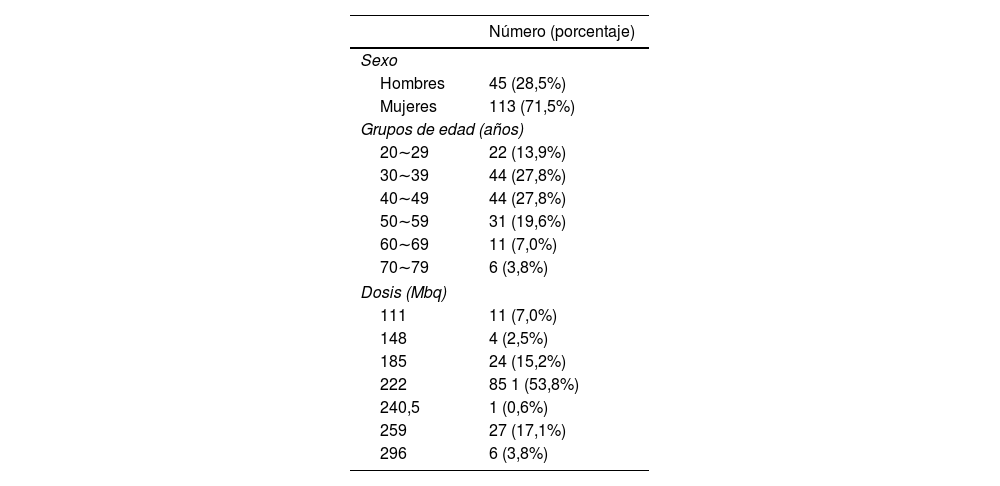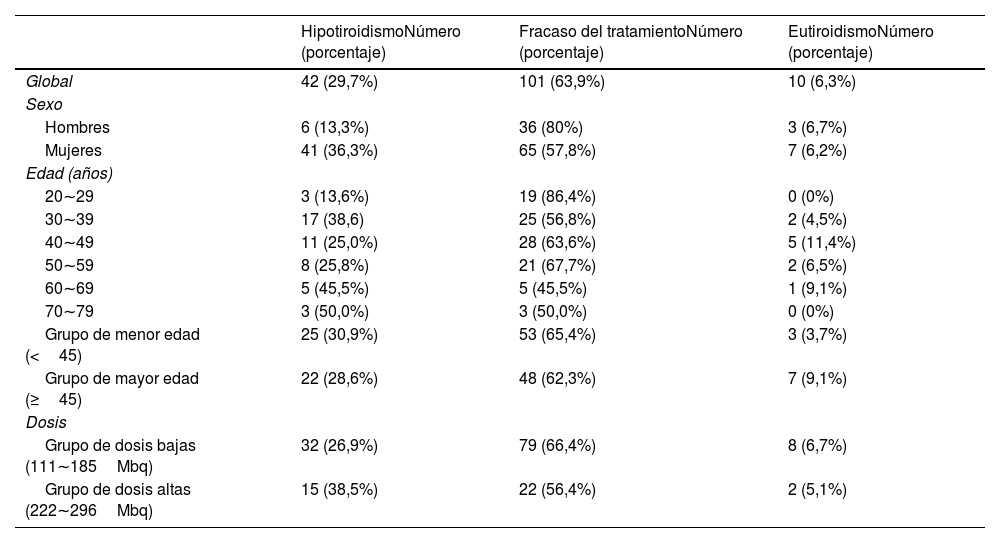El estudio tuvo como objetivo analizar el resultado del tratamiento del hipertiroidismo con yodo radiactivo (RAI, por sus siglas en inglés) a dosis bajas, así como determinar si la edad y el género influyen en el resultado, y determinar la incidencia y el intervalo de aparición de hipotiroidismo después del RAI a dosis bajas.
Material y métodosEn el estudio se incluyeron un total de 158 pacientes que recibieron dosis inferiores a 370Mbq de RAI. Se compararon los resultados del tratamiento y la incidencia de hipotiroidismo según el sexo (45 hombres vs. 113 mujeres), edad (77 pacientes ≥45años vs. 81 pacientes <45años) y dosis administrada (39 pacientes recibieron dosis altas de RAI vs. 119 que recibieron dosis bajas con un límite de 222MBq). Los resultados del tratamiento se categorizaron en hipotiroidismo postratamiento, fracaso del tratamiento (hipertiroidismo persistente) y eutiroidismo. En aquellos pacientes que desarrollaron hipotiroidismo, se calculó el tiempo hasta su aparición en relación con la incidencia acumulada a lo largo del mismo.
ResultadosDe los 158 pacientes, 47 (29,7%) desarrollaron hipotiroidismo, 101 (63,9%) mostraron un fracaso del tratamiento y 10 (6,3%) permanecieron eutiroideos tras el tratamiento. La tasa de respuesta (33,6% vs. 43,5%, p=0,260) y la incidencia de hipotiroidismo (26,9% vs. 38,5%, p=0,170) no difirieron significativamente entre los grupos con dosis baja y elevada, así como tampoco entre los grupos de menor y mayor edad (p=0,69 en la tasa de respuesta y p=0,75 en la incidencia de hipotiroidismo). Las mujeres exhibieron una tasa superior de respuesta (42,5% vs. 20,0%, p=0,008) y de incidencia de hipotiroidismo (46,3% vs. 13,3%, p=0,004) en comparación con los hombres. La incidencia de hipotiroidismo apareció con una media de 24,0±29,2 meses, y su incidencia acumulada en el tiempo fue del 47% y del 60% a los seis y doce meses, respectivamente.
ConclusionesEl RAI a dosis bajas presenta una baja tasa de respuesta en el tratamiento del hipertiroidismo. Aunque puede haber una menor incidencia de hipotiroidismo después del RAI a dosis bajas dosis en comparación con el RAI a dosis altas, este puede ocurrir tempranamente después del tratamiento. Además, las mujeres tienen una mayor tasa de respuesta, pero a expensas de una mayor incidencia de hipotiroidismo. Debe considerarse cuidadosamente el equilibrio entre los riesgos y los beneficios de utilizar el RAI a dosis bajas.
The study aimed to analyze the outcome of low-dose radioactive iodine (RAI) treatment for hyperthyroidism, disclose whether age and gender influence the outcome, and determine the incidence and onset time of hypothyroidism following low-dose RAI.
Material and methodsA total of 158 patients who received doses less than 370Mbq RAI were enrolled in the study. Treatment outcome and incidence of hypothyroidism were compared between different gender (45 male vs. 113 female), age (77 patients ≥45years old vs. 81 patients <45years old) and dose (39 patients receiving higher doses RAI vs. 119 receiving lower dose with a cutoff of 222MBq) groups. Treatment outcomes were categorized into post-treatment hypothyroidism, treatment failure (persistent hyperthyroidism), and euthyroidism. In those becoming hypothyroid, time to develop hypothyroidism was calculated for cumulative incidences over time.
ResultsOut of 158 patients, 47 (29.7%) developed hypothyroidism, 101 (63.9%) had treatment failure, and 10 (6.3%) remained euthyroid after treatment. Response rates (33.6% vs. 43.5%, P=.260) and hypothyroidism incidences (26.9% vs. 38.5%, P=.170) did not differ significantly between lower and higher dose groups, neither between lower and higher age groups (P=.69 in response rates and P=.75 in hypothyroidism incidence). Females exhibited higher response rates (42.5% vs. 20.0%, P=.008) and hypothyroidism incidence (46.3% vs. 13.3%, P=.004) compared to males. Hypothyroidism onset occurred at a mean of 24.0±29.2 months, and the cumulative incidences over time were 47% and 60% in six and twelve months, respectively.
ConclusionsLow-dose RAI has a low response rate for treating hyperthyroidism. Although there may be a lower incidence of hypothyroidism following low-dose RAI compared to high-dose RAI, hypothyroidism may occur early after treatment. Besides, females have higher response rates but more incidence of hypothyroidism. The balance between the risks and benefits of using low-dose RAI should be taken into deliberate consideration.
Artículo
Comprando el artículo el PDF del mismo podrá ser descargado
Precio 19,34 €
Comprar ahora










